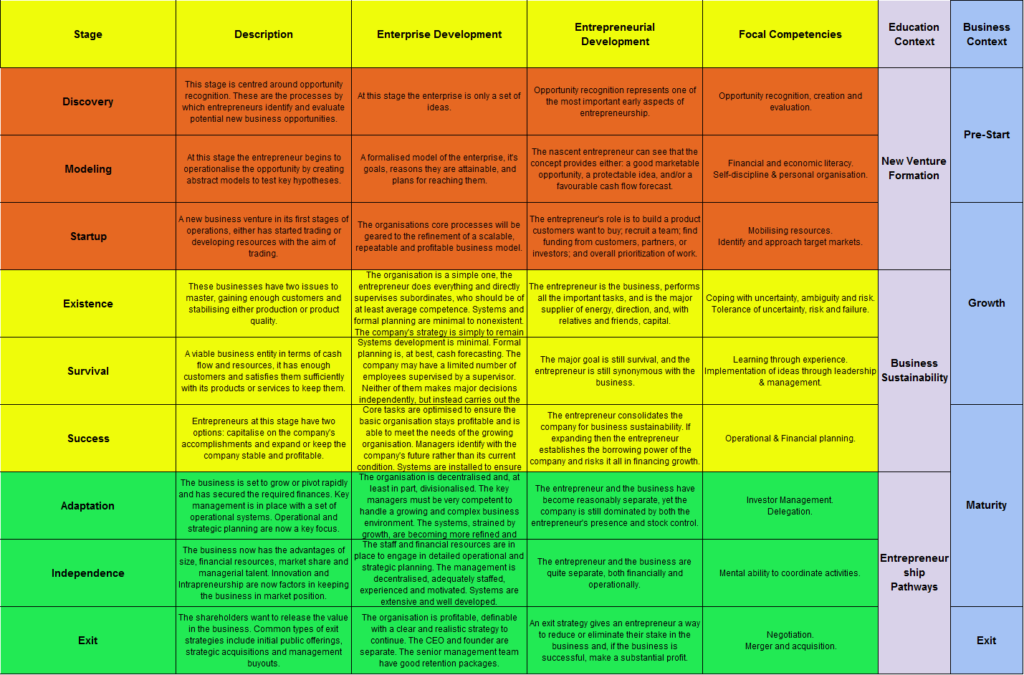How a structured approach to entrepreneurship can drive national economic development
Entrepreneurship is often romanticized as a chaotic, unpredictable journey—but the truth is, behind every successful business lies a lifecycle. Just as humans grow through distinct stages, so do entrepreneurial ventures.
Over the past few years—through my work in academia, consultancy, and government advising—I’ve found that helping people understand where they are in the entrepreneurial journey can make the difference between failure and flourishing.
That’s why I developed a practical framework called the 9 Stages of the Entrepreneurial Lifecycle. This model doesn’t just help entrepreneurs navigate their own paths—it also provides governments, educators, and economic developers with a blueprint for building an entrepreneurial nation.
Let’s take a closer look.
The 9 Stages of the Entrepreneurial Lifecycle
Each stage reflects a different phase in a business’s evolution—from the first spark of an idea to a successful exit. Here’s how it breaks down:
1. Discovery – Spotting the Opportunity
This is where it all begins. Entrepreneurs identify problems, needs, or gaps in the market.
🧠 Connected blogs:
Why Every Entrepreneur Needs to Master the Art of Opportunity Recognition
9 Stages of Enterprise Creation: Stage 1 – Discovery
2. Modeling – Designing the Business Blueprint
Once the opportunity is clear, the focus shifts to business models, customer segments, value propositions, and revenue streams.
🧠 Connected blogs:
9 Stages of Enterprise Creation: Stage 2 – Modeling
The Business Plan – Deep Dive into Financial Planning
Developing a business process diagram for your startup
3. Startup – From Idea to Action
The venture becomes real—founders mobilize resources, form teams, build MVPs, and launch early versions of their product or service.
🧠 Connected blogs:
9 Stages of Enterprise Creation: Stage 3 – Startup
Revolutionizing Startups: Harnessing AI for Efficiency and Growth Without Relying on Cheap Labour
4. Existence – Validating the Market Fit
The business acquires early customers and proves the value proposition. It’s about proving the concept works in the real world.
🧠 Connected blogs:
9 Stages of Enterprise Creation: Stage 4 – Existence
Its Sunday Afternoon, what should I do?
5. Survival – Achieving Sustainability
This is where many ventures struggle. They need enough cash flow to cover costs, scale operations, and survive the lean times.
🧠 Connected blogs:
9 Stages of Enterprise Creation: Stage 5 – Survival
The Importance of Mental Health for Entrepreneurs
6. Success – Growing and Expanding
Now it’s about taking off. Businesses in this stage often seek funding, expand their teams, enter new markets, or optimize their operations.
🧠 Connected blogs:
9 Stages of Enterprise Creation: Stage 6 – Success
The Role of Mentorship in Entrepreneurial Success
Understanding Locus of Control: A Key to Entrepreneurial Success
7. Adaptation – Responding to Change
Markets shift. Competitors appear. New technologies disrupt. Adaptable businesses innovate and pivot to stay relevant.
🧠 Connected blogs:
9 Stages of Enterprise Creation: Stage 7 – Adaptation
Building an Inclusive Culture from the Ground Up: A Guide for Leaders and Founders
8. Independence – Owning the Market
These businesses are now robust, profitable, and self-sustaining. They often become leaders in their space.
🧠 Connected blogs:
9 Stages of Enterprise Creation: Stage 8 – Independence
Remember your motive for starting a business
9. Exit – Passing the Torch
Founders may sell the company, go public, or transition to a new leadership team. This frees capital and energy for the next idea.
🧠 Connected blogs:
9 Stages of Enterprise Creation: Stage 9 – Exit
Do you know your Exit Strategy?
Why This Model Matters for National Economic Development
Too often, economic development policy focuses narrowly on startup support—but this ignores the reality that entrepreneurial needs evolve.
By using the 9-stage model, governments and support organizations can:
✅ Design targeted interventions (e.g., ideation grants vs. scale-up finance)
✅ Measure success more accurately across each stage
✅ Create stage-specific training, mentoring, and funding tools
✅ Avoid one-size-fits-all policies that fail to meet real needs
✅ Support entrepreneurial ecosystems that are holistic, not fragmented
Just imagine the power of national strategies that don’t just encourage people to start businesses—but help them grow, adapt, succeed, and exit effectively.
Embedding the Lifecycle in Education and Practice
At Albion Business School and through our entrepreneurship programmes, we’re embedding this lifecycle into student learning—from foundation year to graduate-level projects. We also encourage schools to introduce the concept at an earlier age.
🧠 Connected blog: Building Entrepreneurial Mindsets in Teenagers: Lessons from Education and Practice
When young people understand the journey of entrepreneurship, they stop expecting overnight success—and start building step by step.
Final Thoughts: A Pathway to Prosperity
We live in an age where economic transformation is urgently needed—whether due to climate challenges, digital disruption, or population shifts.
Entrepreneurship, when supported well, has the power to revitalise economies, create meaningful jobs, and build national resilience.
The 9 Stages of the Entrepreneurial Lifecycle provides more than just a roadmap for individuals—it offers a strategic tool for countries and communities to design better support, smarter policies, and more successful ventures.
Let’s stop guessing what entrepreneurs need—and start guiding them with clarity and purpose.






